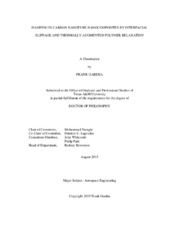| dc.description.abstract | The present work investigates the damping potential of carbon nanotube (CNT) reinforced polymer matrix composites through integrated experiments and continuum modeling techniques. Both “passive" and “active” damping are studied. The passive damping here refers to the inherent capability of a composite to damp vibrations in the absence of external stimuli, such as electrical signals, by exploiting different damping mechanisms introduced by the presence of the nanoscale reinforcements. Among the targeted passive damping mechanisms in nanocomposites is a ‘slip-stick’ mechanism in which the interactions between the filler and polymer results in energy dissipation in a frictional mode along the interface. Microstructural design of nanocomposites, such as the development of CNT alignment, was pursued here to enhance the contribution of interfacial sliding to damping, relative to other mechanisms such as stress concentrations within the matrix and matrix plasticity. A micromechanics model was used to provide additional insight into the experimental observations by showing that the nonlinear variation of damping with dynamic strain can be attributed to slip-stick behavior. The dependence of the interfacial load-transfer reversibility on the dynamic strain history and characteristic time scale was experimentally investigated to demonstrate the relative significance of van der Waals (vdW) interactions, mechanical interlocking, and covalent bonding on shear interactions.
In this effort, we also studied the controllability of energy dissipation capability in nanocomposites via electrical signals, referred to as active damping. This mechanism benefits from the electrically conductive network of CNTs, as well as their high surface to volume ratio, to thermally enhance viscous phenomena, such as chain relaxation in polymers. For active damping, the thermomechanical response of the polymer is targeted and studied as a potential damping source within the nanocomposite. By taking advantage of the polymer relaxation resulting from an increase in temperature, the composite shows the potential for damping enhancement. However, the non-uniform temperature distribution in the composite sample has a large effect on the overall damping enhancement. The non-uniformity of the temperature distribution, both locally and globally, was studied via experiments and multi-resolution models to further shed light on this phenomenon.
This effort clearly points to the significance of interface phenomena, both friction between filler and matrix and energy transfer from the fillers to the matrix, in controlling the damping mechanisms in nanocomposites and presents insights, both qualitative and quantitative, into the origins of these effects. | en |


